Download the Printable Version Here
November 21, 2017
INTRODUCTION
Pitching a “perfect game” is a great achievement in baseball because there are many chances for the opponent, teammates, or even the pitchers themselves, to derail the attempt. Consequently, a perfect game is difficult to achieve and seldom completed. Similarly, significant tax reform is often touted in political campaigns, but due to various competing interests, is rarely accomplished. Typically, the complexity of the process ultimately limits the breadth of the final outcome to a scaled-down temporary (e.g. expiring) solution. With a Republican majority in both the House and Senate and a Republican President, all of the elements are in place to finally pass major tax reform legislation in the near future…unless a wild pitch hits the batter and ruins the whole game.
The current Internal Revenue Code is over 5,000 pages long and weighs almost eight pounds – a major revision and simplification is well overdue. The House and the Senate are both working on separate bills in an attempt to meet that goal. Given the divisiveness and lack of political cooperation within Congress, not to mention the countless constituents and lobbyists expressing dissatisfaction, many of the provisions in both recently released bills will be revised or even eliminated altogether before the final bill is signed into law. While we are still in the “third inning” and have a long way until the end, the initial versions of the bills do show a couple overall themes: 1) the largest portion of the tax savings will accrue to large corporations and business owners; 2) some taxpayers at all income levels will see reduced taxes and simplified filings; 3) some taxpayers at all income levels will see increased taxes; and 4) new provisions will create additional complexity to the Code providing job security for CPAs for years to come.
Once again, Congress is making the tax planning process difficult for accountants and taxpayers as December 31st approaches. Even provisions that are similar between the two bills, and likely to be implemented, may not be effective until 2019. Therefore, the 2017 edition of the Blume Keeney Year-End Tax Planning Guide is intended to feature the tax planning items that work with existing tax law.
The most recent perfect game pitched in Major League Baseball was by Felix Hernandez of the Seattle Mariners, back in 2012, over 5 years ago. The last time Congress passed major tax reform was in 1986, over 30 years ago. With the current state of politics and the complexities of issuing tax legislation that will impact every taxpayer in the country, the final bill will likely be anything but perfect.
We will continue to monitor developments of the new tax legislation – revisions are coming out almost daily – and pass along updates and revised planning ideas if these proposals become certain. In the meantime, you will want to spend some time thinking about your taxes for 2017. Your particular situation changes from year to year so it is important to read through the guide and identify any areas that might apply. Give Jenny or Ryan a call so that we can personally talk with you about the current state of the legislation and the opportunities it creates for you.
TAX PLANNING CHECKLIST FOR INDIVIDUALS
Income Planning
- Tax-Exempt Income – Review investment portfolios to consider exposure to municipal bonds. Not only is the interest tax-exempt, it’s also not subject to the 3.8% Net Investment Income Tax (NIIT) that might apply to other taxable income.
- 0% Tax Rate Income – For taxpayers in the 10% or 15% income tax brackets, long-term capital gains and qualified dividend income is taxed at 0%. So if you are in one of these tax brackets, consider capital gain harvesting before year-end to increase basis within a portfolio. Note that wash sale rules that limit capital losses do not apply to gains.
- Suspended Passive Losses – Review your passive loss carryovers if selling real estate or business interests. Losses from a passive activity that are not allowed to offset current income due to the passive loss rules are suspended and carried forward. Disposing of a passive activity with suspended losses allows the current year losses and suspended losses to offset income.
- Income Deferral – When possible, recognize income after year-end, especially with the potential for lower taxes in 2018. For example, defer bonuses or delay stock option exercises and asset sales.
- Passive Income – Explore ways to increase the level of participation with passive entities or rental properties to avoid the additional NIIT. Income from passive activities may be subject to the NIIT 3.8% surtax in addition to income tax. However, this can be mitigated if taxpayers can meet one of the tests for material participation.
- IRA Conversion Strategy – Evaluate your IRA and anticipated income level for 2017 to determine if a portion of your IRA should be converted to a Roth IRA. This conversion will create additional taxable income in the current year but the distributions from the converted account will be income tax free in future years.
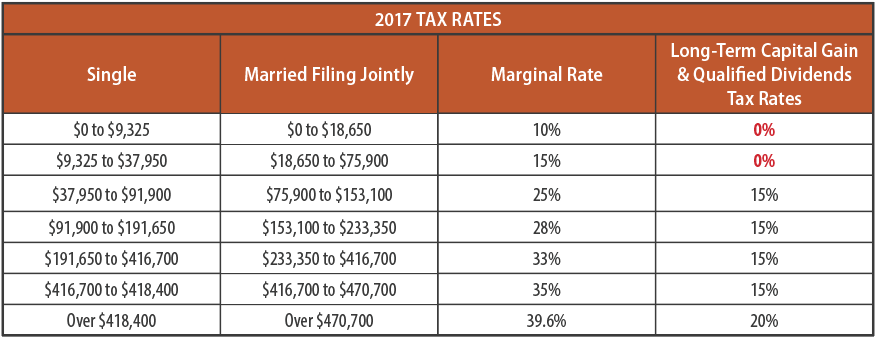
- Age 70.5 Initial Required Minimum Distribution – If you turn age 70.5 during 2017, you have until April 1, 2018 to take your initial required minimum distribution (RMD) from retirement plans. However, if you do wait until 2018, you will then have a double distribution in the same year potentially causing negative tax implications. To avoid that, consider taking your age 70.5 RMD prior to year-end.
- Installment Sale – Consider deferring gain recognition with assets sold on installment until the tax year when proceeds are actually received.
- Like-Kind Exchange – Consider using a like-kind exchange on the sale of rental or business property to defer taxable gains.
- Long-Term Capital Gains and Qualified Dividends – Review investment portfolios to take advantage of the preferential income tax rate for long-term capital gains and qualified dividends.
- Child’s Income – Transfer income producing assets, or appreciated property to kids to utilize their (generally) lower tax bracket. However, the Kiddie Tax could eliminate a majority of the tax savings if the child is under age 18, or under age 24 and a full time student.

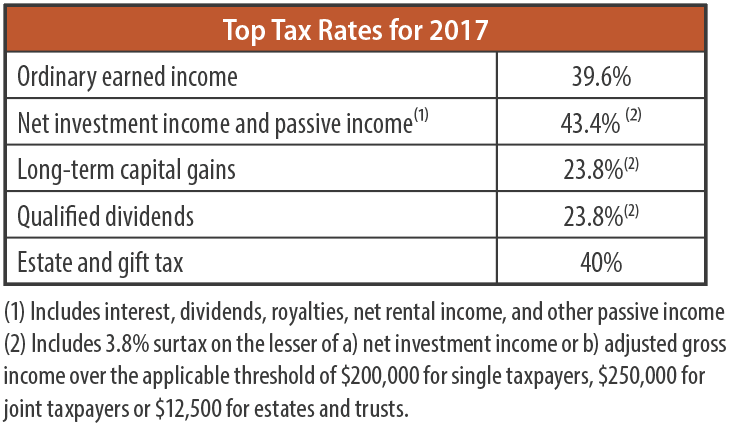
- Same-Sex Marriage – New guidance relating to same-sex marriage has changed tax return filing requirements for certain individuals and created opportunities to potentially reduce income taxes. Furthermore, these changes apply retroactively so it is important to consider prior year tax returns in light of these changes.
- Capital Loss Harvesting – Market appreciation during the year may have generated realized capital gains. Review your portfolio to utilize any unrealized capital losses (when appropriate) to mitigate capital gains. Capital losses can be used to offset capital gains, and unused losses are carried forward to offset future capital gains. However, the wash sale rules impact the benefit if the same asset is reacquired within a specified time period.
- Foreign Bank Accounts – With some exceptions, bank accounts, securities, mutual funds, online poker accounts, or insurance policies with cash value that are physically located outside the U.S. must disclose the foreign account to avoid penalties. This applies to employees with signature authority and foreign retirement accounts.
Deduction Planning
- Retirement Plan Contributions – Certain plans, such as 401(k) and Keogh plans allow larger tax deductions than IRAs or SEP IRAs but they must be established by year-end.
- Over Age 50 Retirement Plan Contributions – If over age 50, be sure to utilize the “catch-up contribution” that allows for an additional $6,000 contribution to a 401(k) and a $1,000 contribution to an IRA in addition to the regular contribution limits.
- Health Savings Account (HSA) Contributions – If eligible, contributions to a HSA are tax deductible and eligible distributions are tax-free.
- Deduction Phase-Outs – Consider bunching two years of deductions into one year by accelerating or deferring deductions, like medical expenses, mortgage interest, state income taxes, real estate taxes, and charitable contributions to exceed the phase-outs and maximize the deduction benefit.
- Charitable Contributions – Consider giving appreciated property to a charity instead of cash to receive a deduction for the fair market value and avoid paying tax on the capital gain. Conversely, depreciated investment assets should be sold first, and the cash donated to charity to receive the benefit of the capital loss.
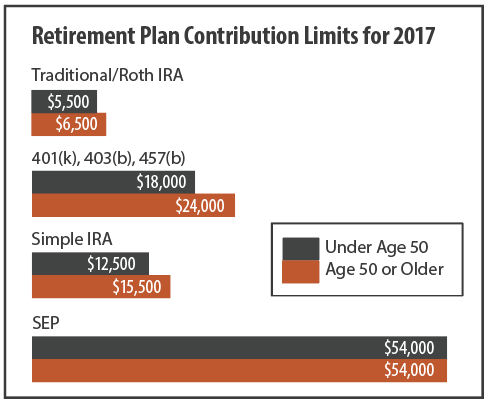
- Charitable Miles – A deduction of $0.14 per mile is allowed when using a vehicle for charitable purposes, plus parking fees and tolls.
- Timing of Charitable Contributions – Credit card charges and checks mailed on or before December 31, though not actually paid until 2018, are still considered deductions in 2017.
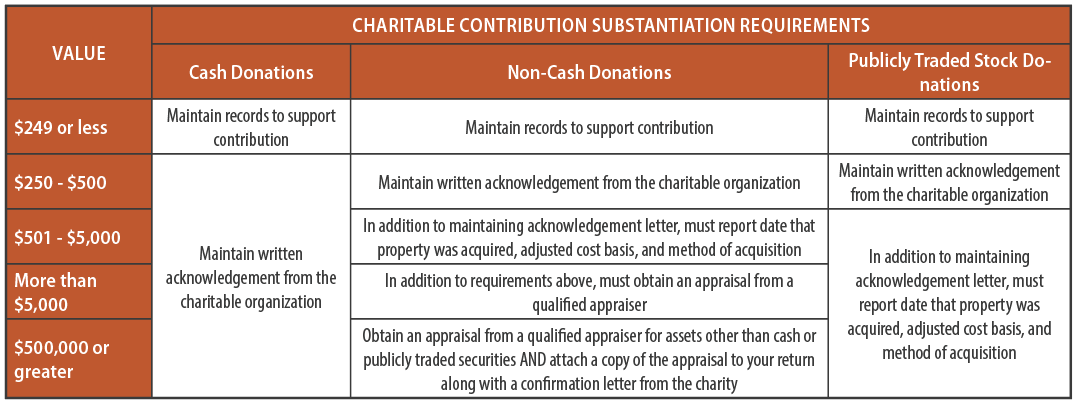
- Substantiation of Charitable Contributions – The IRS has been disallowing charitable contribution deductions when taxpayers are unable to completely meet the substantiation requirements. When giving over $250 to charity, be sure to get an acknowledgement letter from the charity. It would even be advisable to take a photo of non-cash items contributed. (See chart on previous page)
- Qualified Charitable Distribution (QCD) – If over age 70.5, you can make tax-free distributions from your IRA of up to $100,000 directly to charitable organizations. These distributions are excluded from your taxable income.
- School Teachers – Elementary and secondary school teachers are allowed to deduct up to $250 on books, supplies, and materials purchased for their classrooms.
- Residential Energy Tax Credits – The tax credit for installing most types of energy efficient property has expired with the exception of solar property. The 30% credit for installing solar property does not expire until December 31, 2021.
- Education Credits and Deductions – New for 2017, to be eligible for the American opportunity tax credit or the lifetime learning credit, taxpayers must have a Form 1098-T from the educational institution. Information from the Form 1098-T is needed to claim the credits or deductions.
Estate and Gift Planning
- Annual Exclusion – Every taxpayer has a $14,000 per-recipient annual exclusion from gift tax. Combined with a spouse’s annual exclusion, a married couple can give $28,000 per recipient. Consider evaluating your gifting options before year-end.
- Federal Lifetime Exemption – The federal lifetime exemptions for gift and estate tax is now $5.49 million (this is in addition to the $14,000 per-recipient annual exclusions for lifetime gifts referenced above). The gift and estate tax rate for transfers greater than $5.49 million is 40% for 2017.
- State Estate Tax – Some states, including Washington, Oregon, and Massachusetts, have state estate taxes. The state exemptions are lower than the federal exemption so it is important to consider state estate taxes in your estate plans.
- Charitable Gifts – Taxpayers with significant charitable intent may be able to receive both an income tax benefit and an estate tax benefit with proper planning.
- Interest Rates – Applicable federal rates (AFRs), minimum interest rates that are required to be charged by related parties, continue to be at historical lows. In some cases, it may be possible to refinance loans between related parties to reduce interest payments.
- Valuation Discounts – Discounts have been an extremely valuable tool in the estate planning arena for decades. Recent proposed regulations from Treasury to limit the application of these discounts have been withdrawn so this strategy is still available.
- Same-Sex Marriage – New guidance relating to same-sex marriage has created opportunities for certain individuals. Wills and other estate planning documents should be updated to incorporate these new opportunities.
Affordable Care Act – Health Insurance
- Required Insurance – All U.S. citizens and legal residents are required to have qualifying health insurance. There are some exemptions, primarily due to financial hardship or short-term gaps in coverage.
- Penalties – The penalty for not obtaining qualifying health coverage has increased to the greater of $695 per adult ($347.50 per child) or 2.5% of household income in 2017. Maximum penalties of $2,085 apply.
- Premium Tax Credits – Taxpayers with household incomes below four times the federal poverty limit ($48,240 for an individual, $98,400 for a family of four) may qualify for a premium tax credit or a premium subsidy.
- Reporting – A Form 1095-A, 1095-B, or 1095-C will be issued to anyone enrolled in health insurance during the year substantiating health insurance coverage for the calendar year. These forms will be needed to complete the Form 1040.
TAX PLANNING CHECKLIST FOR TRUSTS
- Distributions – Trusts have a low threshold of $12,500 for the NIIT so most undistributed income in a trust will be subject to the additional tax. Trustees should consider maximizing distributions to beneficiaries, and consider strategies to distribute capital gains.
- Income Sources – Similar to the tax planning strategies for individuals, trustees should evaluate the role of tax-exempt income in the trust’s investment portfolio given the 3.8% NIIT on taxable income.
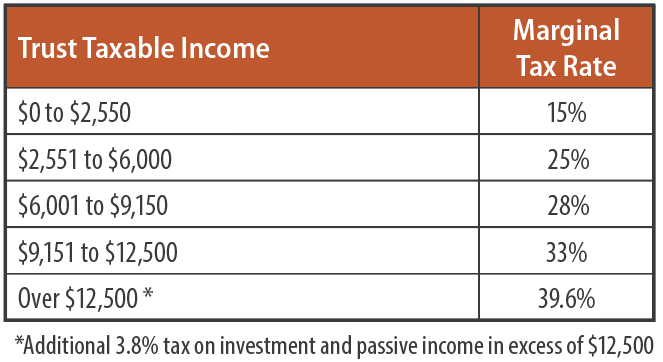

- Passive Activities – IRS guidance has clarified the application of NIIT on a trust’s business and/or real estate income. In light of this new guidance, consider the role of a trustee in the management of the trust assets and whether additional steps can be taken to mitigate this additional tax.
TAX PLANNING CHECKLIST FOR BUSINESSES
- Form W-2 – The filing deadline for Forms W-2/W-3 is January 31. Employers are also required to disclose the annual cost of health plan or HRA coverage to an employee on the W-2.
- Health Insurance – Employers with 50 or more FTE employees must offer minimum essential coverage and report insurance coverage for employees on Forms 1094-B, 1094-C, 1095-B, and 1095-C
- Limitation on Health FSA Reimbursements – The maximum Health FSA reimbursement may not exceed $2,600 per year for 2017.
- Section 179 – The Section 179 depreciation deduction for qualifying assets acquired in 2017 is $510,000. This depreciation deduction begins to phase out once total depreciable assets purchased during the year exceed $2,030,000.
- Buy-Sell Agreements – Buy-Sell Agreements can act as a will for businesses. Agreements should be reviewed and updated regularly. This is especially important in any business with multiple owners.
- Bonus Depreciation – 50% bonus depreciation has been extended through 2017, with 40% bonus depreciation in 2018, and 30% bonus depreciation in 2019. Bonus depreciation is scheduled to expire after 2019 but the new legislation would allow 100% expensing of qualified assets.
- Family Employees – Consider hiring your school-age child to work for your business part-time. Reasonable compensation is deductible, reducing your self-employment income. No Social Security or Medicare tax is due on the child’s earnings if they are under age 18 and the business is not a corporation. Also, the child could make a contribution to a traditional or Roth IRA.
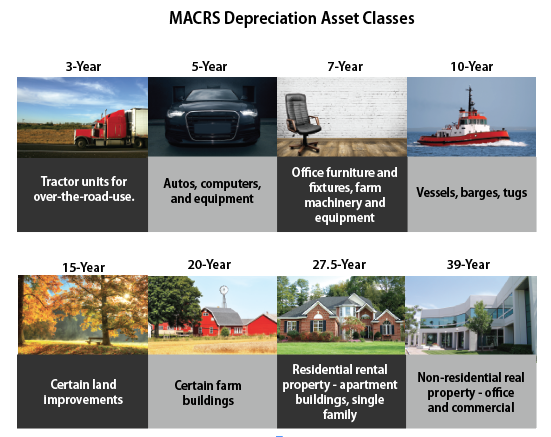
- Form 1099 – Any non-corporate vendor paid over $600 must be issued a Form 1099 to report payments. The Form 1099/1096 is due by January 31 and the penalty for late filing can be as high as $530 per Form 1099 with no maximum penalty. The IRS has emphasized greater enforcement of the Form 1099 compliance process.
- Small Business Health Care Tax Credit for Small Employers – Small employers, generally those with fewer than 25 full-time equivalent employees with average wages of $50,000 or less, are allowed a maximum credit for 50 percent of premiums paid for employees health insurance. Insurance must be purchased through the Small Business Health Options Program (SHOP) or qualify for an exception to the requirement.
- Work Opportunity Tax Credit – Employers who hire and retain veterans and other qualified individuals, including long-term unemployment recipients, are eligible for a tax credit up to 40% of the employee’s wages.
- Health Reimbursement Arrangement (HRA) – Employers with fewer than 50 employees and no company provided health insurance can utilize an HRA to reimburse employees for healthcare expenditures. Annual reimbursements are limited to $5,050 for employee only coverage and $10,250 for family coverage.
- Employer-Provided Child Care Credit – Employers can claim a credit of up to $150,000 for supporting employee child care or child care resource and referral services.
- Research and Development Credit – Companies that develop new or improved products or processes may be able to benefit from research tax credit incentives. The research tax credit law was permanently extended.
- Qualified Small Business Stock (Section 1202) – Sec. 1202 stock provides an exclusion of gain from certain small business stock sales in C corporations. The exclusion can be as high as 100% of the gain.
IMPORTANT TAX DUE DATES
For Businesses, Individuals, and Trusts
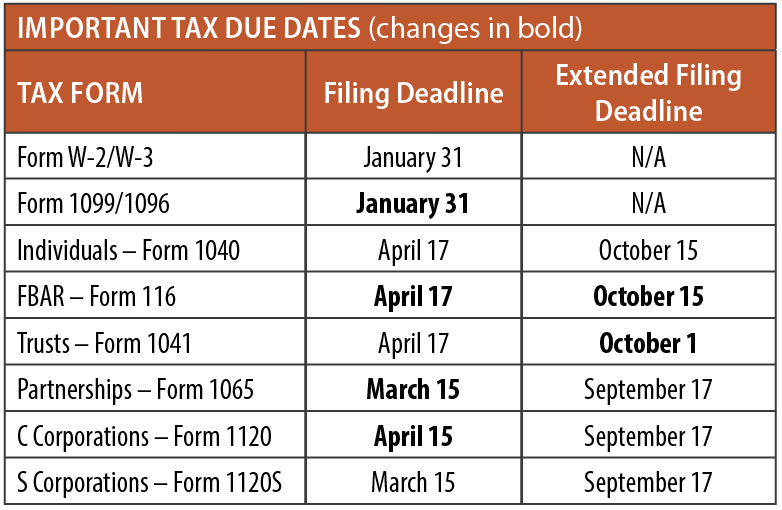

Regardless of your political preferences, there is benefit to being aware of the tax planning opportunities available to you for 2017 and beyond. Decisions you make this year could have a direct impact on your long term financial security, so it pays to plan and take action now to ensure your goals can be achieved.
Contact Jenny Keeney or Ryan Blume for more information.
(425) 404-3540

Jenny Keeney, CPA, MPAcc
Partner
(425) 404-3544
jenny@blumekeeney.wpmudev.host

Ryan Blume, CPA, CFP®
Partner
(425) 404-3545
ryan@blumekeeney.wpmudev.host
Any tax advice contained in this communication, unless expressly stated otherwise, was not intended or written to be used, and cannot be used, for the purpose of (i) avoiding tax-related penalties that may be imposed on the taxpayer under the Internal Revenue Code or applicable state or local tax law or (ii) promoting, marketing, or recommending to another party any tax-related matters addressed herein.


